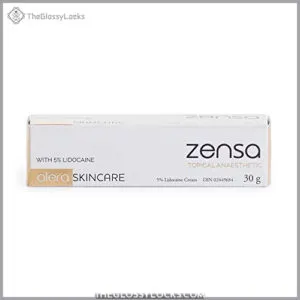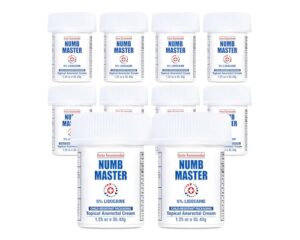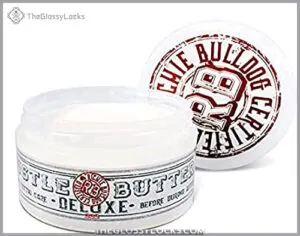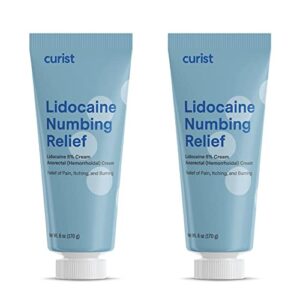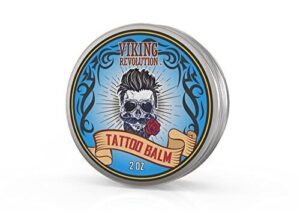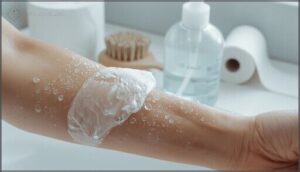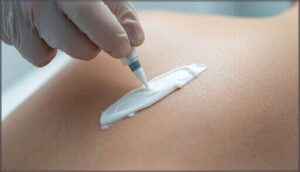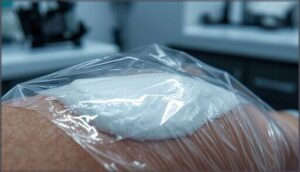This site is supported by our readers. We may earn a commission, at no cost to you, if you purchase through links.
Your skin’s about to face needles for hours, and you’re staring down a decision that separates a manageable tattoo session from an ordeal: which numbing cream actually works. Lidocaine-based formulas made up 42.6% of topical anesthetics prescribed in 2023, but concentration levels, absorption rates, and ingredient combinations create wildly different experiences.
A 5% lidocaine cream with the right base formula can cut sensation by 80% within 30 minutes, while a poorly formulated alternative might barely take the edge off. Water-based options absorb faster when covered with plastic wrap—boosting effectiveness by 300-500%—but oil-based versions deliver longer-lasting relief for extended sessions.
Safety matters as much as strength, since allergic reactions and toxicity symptoms can derail your appointment faster than any pain threshold.
Table Of Contents
- Key Takeaways
- What Makes an Effective Numbing Cream
- Factors to Consider When Choosing Numbing Cream
- Top 9 Best Numbing Creams for Tattoos & Piercings
- 1. Maximum Strength Numbing Cream
- 2. Fast Acting Numbing Cream Relief
- 3. Fast Acting Numbing Pain Relief Cream
- 4. Lidocaine Numbing Pain Relief Cream
- 5. Numbing Foaming Soap For Tattoos
- 6. Vegan Tattoo Healing Balm Cream
- 7. Fast Acting Lidocaine Numbing Cream
- 8. Lidocaine Pain Relief Cream Maximum Strength
- 9. Natural Tattoo Aftercare Moisturizing Balm
- How to Apply Tattoo Numbing Cream Correctly
- Safety Tips and Precautions for Numbing Cream Use
- Frequently Asked Questions (FAQs)
- How long should I wait before using a numbing cream?
- Is it safe to use numbing cream while pregnant or breastfeeding?
- How often can I use numbing cream?
- Are there any side effects to using numbing cream?
- Does numbing cream work on all skin types?
- Can numbing cream be used during pregnancy or breastfeeding?
- How should numbing cream be stored for longevity?
- Can numbing cream expire and lose its effectiveness?
- Is numbing cream covered by health insurance plans?
- Conclusion
Key Takeaways
- A 5% lidocaine cream with proper formulation can reduce sensation by 80% within 30 minutes, but effectiveness depends heavily on the base formula—water-based versions absorb faster when covered with plastic wrap (boosting effectiveness by 300-500%), while oil-based options provide longer-lasting relief for extended tattoo sessions.
- Maximum strength over-the-counter numbing creams contain 4-5% lidocaine and can cut pain scores by up to 50%, but timing matters critically—you need to apply them 45-60 minutes before your session, and peak numbing effect hits around 60 minutes with relief typically lasting 1-3 hours.
- Lidocaine toxicity isn’t just theoretical risk—poisoning deaths nearly tripled between 2016 and 2021, so you must stick to safe dosage limits of 4.5 mg/kg per application (capped at 300 mg total) and never exceed four applications daily or apply to broken skin where absorption spikes dangerously.
- True lidocaine allergies affect only 1-2% of users, but you should always patch test 24-48 hours before your appointment on a small area to catch reactions early—watch for persistent redness, raised welts, or intense burning that worsens over time rather than fades.
What Makes an Effective Numbing Cream
Not all numbing creams work the same way, and understanding what goes into them helps you make a safer choice. The right formula depends on the active ingredients, how they’re delivered to your skin, and whether they match your skin type.
Let’s break down the key factors that separate effective numbing creams from the rest.
Lidocaine and Other Active Ingredients
Lidocaine is the workhorse in most tattoo numbing creams because it blocks sodium channels in nerve cells, stopping pain signals before they reach your brain. You’ll also find benzocaine, prilocaine, and tetracaine in some formulas, often combined for stronger anesthetic potency.
- Lidocaine-based creams made up 42.6% of topical anesthetics prescribed in 2023
- Multi-agent formulas like EMLA deliver better pain relief than single-ingredient options
- Benzocaine carries higher allergy risks compared to lidocaine alone
The effectiveness of lidocaine can be further understood by examining drug usage statistics to determine its potency and application.
Strength and Concentration Levels
Over-the-counter numbing creams generally contain 4-5% lidocaine concentration, which provides adequate pain relief for most tattoo sessions. Prescription strength formulas exceed 5% lidocaine content but require medical supervision due to toxicity risks. Higher concentrations deliver faster onset and longer relief, but safe dosage matters more than maximum strength.
Benzocaine alternatives like prilocaine offer options if you’re sensitive to standard lidocaine formulas. For minor skin irritations, OTC lidocaine cream can also provide relief from pain and itching.
Water-Based Vs. Oil-Based Formulas
Beyond concentration, the formula base affects how numbing cream ingredients work on your skin. Water-based numbing creams absorb faster, reaching peak effect in 20-25 minutes with minimal residue. Oil-based versions take longer but provide sustained relief and built-in moisture. Absorption rates jump 300-500% when you cover water-based formulas with plastic wrap.
Consider these ingredient compatibility factors:
- Water-based options leave less greasy film, simplifying cleanup before your tattoo session
- Oil-based creams naturally occlude without wrapping, extending duration but potentially interfering with stencils
- Both types carry similar lidocaine concentrations (2-5%), though application differences impact onset speed
Choose based on your procedure length and skin sensitivity considerations rather than assuming stronger means better.
Suitable Skin Types and Sensitivity
Your skin type matters more than formula choice. Allergic reactions to lidocaine affect only 1.4% of users, but sensitive skin demands extra caution.
Look for hypoallergenic options like EMLA cream if you’re prone to skin irritation or have a history of atopic dermatitis. Women experience higher rates of sensitivity reactions, and broken skin increases absorption risks considerably.
Patch test first when skin sensitivity is a concern.
Factors to Consider When Choosing Numbing Cream
Not all numbing creams work the same way, and the right choice depends on more than just strength. You need to think about how long the relief lasts, where you’re applying it, and what’s actually in the formula.
Here’s what matters most when you’re comparing your options.
Duration of Pain Relief
You’ll want to know how long your numbing cream will actually last before committing to that lengthy tattoo session. Most lidocaine-based creams provide pain relief for 1-3 hours, though ingredient variance and skin thickness affect this considerably.
Peak effect hits around 60 minutes after application. Extended numbing effect beyond 4 hours raises safety trade-offs, including potential toxicity concerns.
Application Time and Guidelines
Most tattoo numbing cream application instructions recommend applying 60-90 minutes before your session for the best duration of anesthesia. You’ll need occlusion methods—like plastic wrap—to boost skin penetration.
Don’t exceed manufacturer pre-procedure timing guidelines, and wait at least two hours before reapplication safety allows a second dose. Post-removal effects actually intensify for 30 minutes, so timing matters.
Area of Use (Body, Face, Piercings)
When choosing tattoo numbing cream, you’ll face different safety profiles depending on location. Body applications generally tolerate higher lidocaine concentrations, while facial skin requires cautious dosing—especially near eyes and mucous membranes where irritation risks spike.
Piercing relief demands precise placement to avoid systemic absorption. Face tattoos need specialized formulas, and sensitive areas always warrant professional consultation before numbing cream use.
Vegan, Cruelty-Free, and Natural Options
If you prioritize ethical choices, vegan and cruelty-free numbing creams have surged in availability—up 21% since 2022. These plant-based formulas generally contain 2-5% lidocaine alongside natural ingredients like aloe vera and clove oil, which studies show rival benzocaine’s effectiveness.
Look for Leaping Bunny or PETA certifications to verify ethical sourcing. Natural alternatives deliver reliable pain relief with fewer reported irritation rates than conventional options.
Safety and Allergen Considerations
True lidocaine allergies affect less than 1% of users, but allergic reactions can escalate fast. Protect yourself by understanding the risks:
- Patch test first: Apply a small amount to your inner arm for 24 hours to check for skin irritation before your session.
- Watch for toxicity symptoms: Dizziness, rapid heartbeat, or seizures signal dangerous systemic absorption—seek help immediately.
- Choose FDA approved products: They meet safe usage standards and list area restrictions clearly on packaging.
Top 9 Best Numbing Creams for Tattoos & Piercings
The right numbing cream can make your tattoo or piercing experience considerably more comfortable, but not all products deliver the same results.
I’ve reviewed nine top-performing numbing creams based on their active ingredients, duration of relief, and safety profiles.
Here’s what you need to know about each option to find the best fit for your needs.
1. Maximum Strength Numbing Cream
When you’re staring down hours in the tattoo chair, you want serious pain relief—and that means lidocaine concentration matters. Maximum strength numbing cream usually contains 4-5% lidocaine, which clinical performance data shows can cut pain scores by up to 50%.
These formulations dominate 82% of the tattoo numbing market for good reason. Regulatory guidelines cap over-the-counter products at 5%, balancing numbing cream effectiveness with safety.
Absorption rates peak around 60 minutes, so you’ll need patience before your session starts. Professional studios recommend these products in 87% of cases for extended tattoo work.
Best For: Anyone getting a tattoo who wants the strongest legal numbing available, especially if you’re tackling bony spots or sitting for longer sessions.
- Clinical studies show 4-5% lidocaine cuts pain by up to 50%, which is why it dominates 82% of the tattoo numbing market.
- Recommended by professionals in 87% of tattoo studios for extended work and client comfort.
- FDA-approved maximum strength means you’re getting the most effective legal concentration without needing a prescription.
- Takes 20-60 minutes to fully absorb, so you can’t just show up and go—you need to plan ahead.
- Results vary from person to person, and some people report the numbness wearing off after 1-2 hours during longer sessions.
- Higher concentrations mean higher risk if you use too much or apply it to broken skin—FDA warns about seizures and heart issues when misused.
2. Fast Acting Numbing Cream Relief
Dr. Numb leads the fast-acting numbing creams category with a 15-minute onset—ideal when you can’t wait an hour. Lidocaine-based formulas achieve rapid onset in 10-25 minutes, while benzocaine averages 12 minutes but delivers shorter relief duration at just 25 minutes.
Clinical efficacy studies show lidocaine scores consistently lower on pain scales (2.8 VAS) compared to benzocaine (3.5 VAS).
Market trends confirm consumer demand for time-efficient products, driving 5.1% annual U.S. growth.
Comparative evaluation reveals these tattoo numbing cream options work fastest but require reapplication for sessions exceeding 90 minutes.
Best For: Anyone needing quick pain relief for tattoos, piercings, or minor skin procedures who values fast onset over extended duration.
- Works in just 15 minutes—much faster than most numbing creams that need 30-60 minutes to kick in.
- Professional-grade 5% lidocaine formula delivers up to 4 hours of relief and scores well on clinical pain scales.
- Non-greasy and hypoallergenic, so it absorbs quickly without leaving residue or irritating sensitive skin.
- Some users report it wears off in 20-30 minutes instead of the advertised 4 hours, especially during longer procedures.
- At $49.99 for just 30 grams, it’s on the pricier side and may require reapplication for extended sessions.
- Effectiveness varies by skin type and procedure, with mixed reviews suggesting it doesn’t work equally well for everyone.
3. Fast Acting Numbing Pain Relief Cream
Clinical Resolution’s 5% lidocaine formula delivers pain relief in 3-5 minutes—your fastest option when you need immediate numbing. This fast-acting numbing cream peaks within an hour, providing targeted relief for tattoos, piercings, and minor skin irritations.
The oil-free, vitamin E-infused design won’t interfere with tattoo ink transfer. However, you’ll get roughly 60 minutes of effective numbing from peak onset, so plan accordingly for longer sessions.
Market leaders like Dr. Numb offer extended duration, but when speed matters most, this application method gets you numbed quickly.
Best For: People who need quick numbing relief for tattoos, piercings, or minor skin procedures and want results in under 5 minutes.
- Starts numbing in just 3-5 minutes, making it one of the fastest-acting options available for immediate pain relief.
- Oil-free and enriched with Vitamin E and Aloe Vera, so it won’t mess with tattoo ink or leave your skin greasy.
- Maximum strength 5% lidocaine formula provides reliable pain relief for everything from minor cuts to cosmetic procedures.
- Numbing only lasts about an hour from peak effect, which might not be enough for longer tattoo or procedure sessions.
- The 12.5-ounce container is on the smaller side and may run out quickly if you’re using it regularly or for larger areas.
- Some users have reported quality control issues like improperly fitted lids and broken safety seals on arrival.
4. Lidocaine Numbing Pain Relief Cream
Numb520’s 5% lidocaine concentration puts you at maximum strength for topical anesthetic relief without a prescription. You’ll notice numbness within 30-60 minutes on intact skin, lasting 1-2 hours—enough for most tattoo work. The liposomal formula penetrates deeper than standard creams, targeting pain receptors more effectively.
Apply a thick layer to clean, dry skin, then cover with plastic wrap. Clinical studies show this method reduces pain scores from 6.7 to 3.0 over two weeks. Just remember, your skin thickness and metabolism affect how well it works for you.
Best For: People seeking maximum-strength topical numbing for tattoos, minor procedures, or localized pain who want a fast-acting, non-greasy formula that penetrates deeply.
- Maximum 5% lidocaine concentration delivers noticeable numbness in 30-60 minutes and lasts 1-2 hours for most procedures.
- Liposomal formula penetrates deeper than standard creams, with clinical studies showing significant pain reduction from 6.7 to 3.0 on pain scales.
- Oil-free, odor-free, and hypoallergenic design minimizes skin irritation and allergic reactions for most users.
- Effectiveness varies based on individual skin thickness and metabolism, with some users reporting mixed or underwhelming results.
- At $41.64 for 4.8 ounces, it’s pricier than many competitors, which some buyers find expensive for the quantity.
- Requires careful application with plastic wrap covering for 30-60 minutes to achieve optimal numbing, which takes planning ahead.
5. Numbing Foaming Soap For Tattoos
Foaming soap with 4% lidocaine works differently than traditional numbing cream—it cleans and numbs simultaneously. The benzethonium chloride adds antimicrobial protection, while aloe and arnica soothe fresh ink.
You’ll apply it before, during, and after your session, gently massaging the foam onto skin and rinsing with lukewarm water. Don’t be fooled by how much it lathers—foam volume doesn’t equal better pain relief or infection protection.
The real benefit is gentle cleansing without disrupting your healing skin barrier, making it ideal for tattoo aftercare routines.
Best For: Anyone looking for a dual-purpose product that numbs and cleans during tattoo sessions or aftercare, especially if you want antimicrobial protection built in.
- Combines 4% lidocaine numbing with benzethonium chloride to disinfect and prevent infection in one step.
- Gentle foaming formula with aloe and arnica soothes skin without disrupting the healing barrier during aftercare.
- Versatile use before, during, and after tattoo sessions for continuous pain and itch relief.
- External use only with restrictions—can’t be used on large areas, raw surfaces, or blistered skin.
- Foam volume can be misleading since lather doesn’t indicate better pain relief or cleaning power.
- May require doctor consultation if you need to exceed recommended dosage or if symptoms persist.
6. Vegan Tattoo Healing Balm Cream
Plant-based balms won’t numb your skin during tattooing, but they’re game-changers for the healing process afterward. Vegan formulas like shea butter, coconut oil, and calendula extract exclude common allergens—lanolin, beeswax—that trigger reactions in sensitive skin.
You’ll apply a thin layer 2-4 times daily to moisturize and reduce inflammation without petroleum-based ingredients. Studies show 92% of users report less discomfort within two weeks.
These natural ingredients support color retention and barrier repair, making vegan tattoo aftercare products a safe, effective choice for healing.
Best For: People with sensitive skin or ethical concerns who want a plant-based, allergen-free option that moisturizes and supports healing without petroleum or animal-derived ingredients.
- Free from common allergens like lanolin and beeswax, reducing the risk of reactions—96% of users reported minimal itching or burning after one week.
- Natural ingredients like shea butter, calendula, and coconut oil provide anti-inflammatory benefits and help retain tattoo color while supporting skin barrier repair.
- Cruelty-free and vegan-certified with transparent ingredient lists, appealing to eco-conscious consumers and backed by 92% positive user ratings for healing performance.
- Can feel greasy if you apply too much, and some formulas may be less effective in cold weather when the balm thickens.
- The scent from natural plant extracts might be too strong for some users, and occasional packaging issues like missing lids have been reported.
- Higher price point compared to conventional ointments—average cost is around €12 for a small 30g tube—which may not fit every budget.
7. Fast Acting Lidocaine Numbing Cream
You’ll get noticeable pain relief in 25 to 30 minutes with fast-acting lidocaine numbing cream, much faster than older formulas that took two hours. The 4-5% lidocaine concentration in these creams provides clinically proven pain reduction for tattoos and piercings, with absorption rates optimized for rapid onset.
Since the tattoo numbing cream market hit $1 billion in 2025 and continues growing, more reliable options exist. Their safety profile is solid when you follow application guidelines, though you should watch for mild tingling or redness at the site.
Best For: Anyone looking for quick pain relief before tattoos, piercings, laser treatments, or cosmetic procedures who needs effective numbing in under 40 minutes.
- Works fast—you’ll feel numbness in 25-30 minutes instead of waiting hours like older formulas, making it convenient for walk-in appointments or tight schedules.
- Strong 4-5% lidocaine concentration delivers clinically proven pain reduction that actually works for intense procedures like tattoos and laser treatments.
- Safe and reliable when used as directed, with only minor side effects like slight tingling or redness that go away quickly.
- External use only, so it won’t help with internal discomfort or pain that requires deeper penetration beyond the skin surface.
- Can dry out your skin with repeated use, especially if you’re doing multiple sessions close together or have naturally sensitive skin.
- Some products have frustrating packaging with hard-to-open seals, and you might experience mild irritation or allergic reactions depending on your skin type.
8. Lidocaine Pain Relief Cream Maximum Strength
Maximum strength formulas deliver 5% lidocaine concentration in creams for deeper tattoo pain management, though your standard OTC options max out at 4% by FDA regulation. Clinical efficacy studies show these work better than placebo for neuropathic pain, but watch for mild skin irritation or redness.
You’ll notice pain relief within 3 to 5 minutes after application, lasting anywhere from 30 minutes to several hours depending on how thick you apply it. Stick to thin layers every 6 to 8 hours, and don’t exceed four applications daily to avoid adverse effects like methemoglobinemia.
Best For: People looking for fast-acting relief from moderate tattoo pain, neuropathic discomfort, or localized muscle aches who want the strongest over-the-counter numbing option available.
- Works quickly with pain relief kicking in within 3 to 5 minutes of application, so you don’t have to wait long for the numbing effect.
- Clinical studies back it up as more effective than placebo for nerve pain, giving you some real science behind the relief claims.
- Larger 6 oz tubes mean you get 50% more product than standard options, which is better value if you use it regularly.
- Can cause mild skin irritation, burning, or redness at the application site, especially if you have sensitive skin.
- Relief duration varies wildly from 30 minutes to a few hours depending on application thickness and your body’s response, so results aren’t always predictable.
- Requires careful dosing with a maximum of 3 to 4 applications daily to avoid serious risks like methemoglobinemia or systemic toxicity.
9. Natural Tattoo Aftercare Moisturizing Balm
Natural ingredients like shea butter, coconut oil, and aloe vera make these balms a smart aftercare choice once your tattoo session ends. Unlike numbing creams, they won’t numb skin but support healing outcomes by keeping moisture locked in and reducing irritation.
Market trends show over 60% of new aftercare products spotlight plant-derived formulas, reflecting strong demand for sustainability and transparent safety profiles.
You’ll find these balms noncomedogenic and free from petroleum or parabens, minimizing allergic reactions while promoting skin healing and preserving your tattoo’s vibrancy.
Best For: People looking for a natural, skin-friendly aftercare solution that keeps new tattoos moisturized, reduces irritation, and helps preserve ink vibrancy without harsh chemicals.
- Made with natural ingredients like shea butter, coconut oil, and aloe vera that soothe skin and support faster healing without clogging pores.
- Helps maintain tattoo brightness and color over time by keeping skin hydrated and reducing excessive scabbing or dryness.
- Free from petroleum, parabens, and synthetic preservatives, lowering the risk of allergic reactions or irritation during the healing process.
- Some users report similar results using cheaper, more basic moisturizers, so the premium price may not feel justified for everyone.
- Can leave skin feeling slightly oily or greasy after application, which might be uncomfortable in warmer weather.
- The container design can be tricky to open, and it may not fully prevent issues like water blisters or minor scabbing for all skin types.
How to Apply Tattoo Numbing Cream Correctly
Applying numbing cream isn’t complicated, but doing it right makes all the difference in how well it works. The timing, technique, and preparation steps directly affect how much pain relief you’ll actually get during your tattoo session.
Here’s exactly what you need to do before, during, and after application to get maximum numbing power.
Pre-Application Skin Preparation
Before you apply tattoo numbing cream, cleansing techniques matter more than you’d think. Wash your skin with alcohol-based or gentle dermatologic cleanser to remove oils and debris—this boosts absorption by up to 35%.
Mild exfoliation benefits penetration, while allergen screening through patch testing reduces reactions dramatically. Pat dry completely and wait 3–5 minutes. Proper drying time prevents dilution and maximizes effectiveness.
Proper Layering and Coverage
You need a thick layer—about 2mm across the surface area—for consistent numbing. Spread the cream uniformly in one direction, covering at least 0.5 inches beyond your tattoo zone.
Uneven application or patchy coverage accounts for 36% of failures, so don’t rush. Follow dosage guidelines: roughly 2.5 grams per 20-25 cm².
Absorption time matters, but that’s next.
Plastic Wrap Technique
Occlusion benefits are real—sealing your cream under plastic wrap boosts absorption and extends relief up to four hours. Wrap snugly after layering, then wait 45-60 minutes before your session. That application duration guideline maximizes peak effect right when needles start.
- Saran wrap creates an airtight seal over treated skin
- Moisture stays trapped, driving lidocaine deeper into tissue
- Remove wrap completely before tattooing begins
- Alternative dressings like Saniderm reduce irritation risks and infection concerns
Safety concerns? Watch for redness or swelling during occlusion.
Reapplication Tips for Extended Sessions
Once the plastic wrap comes off, your tattoo session duration might demand reapplication—but timing matters. Cleansing before reapplication removes ink residue and sweat, so fresh cream absorbs evenly.
Wait at least one hour between applications, and never exceed 60 grams in 24 hours to stay within dosage safety limits.
Reaction monitoring is key: watch for persistent redness or dizziness. Professional guidance helps adjust application instructions safely.
Safety Tips and Precautions for Numbing Cream Use
Numbing creams work well when you use them correctly, but they’re not risk-free. Your skin can react badly to certain ingredients, and using too much can lead to serious health problems.
Let’s cover what you need to watch for to keep your tattooing experience both comfortable and safe.
Recognizing Allergic Reactions and Irritation
How do you spot the difference between normal sensitivity and a true allergic reaction? Watch for persistent itching, burning, or swelling that doesn’t fade—these signal your skin’s rejection of the product. Key warning signs include:
- Redness spreading beyond the application site
- Raised welts or blistering within hours
- Intense burning that worsens over time
- Persistent inflammation lasting beyond 24 hours
- Systemic symptoms like dizziness or breathing changes
Patch testing on a small area 24 hours before full application catches sensitizers early. Lidocaine causes reactions in roughly 1-2% of users, while additives and preservatives often trigger irritation in people with existing skin sensitivity. If symptoms appear, stop immediately and rinse thoroughly—mild dermatitis usually resolves in 3-5 days.
Management strategies include topical corticosteroids for significant inflammation and switching to alternative formulas. Those with drug allergy history face higher risk factors and should consult a dermatologist before using any numbing cream.
Avoiding Overuse and Toxicity
Toxicity isn’t just theory—lidocaine poisoning deaths nearly tripled between 2016 and 2021. You’re looking at safe dosage limits of 4.5 mg/kg per application, capped at 300 mg total. Overdose triggers seizures, irregular heartbeat, and methemoglobinemia when plasma lidocaine concentration exceeds 5 µg/mL.
Lidocaine poisoning deaths nearly tripled between 2016 and 2021, with overdoses triggering seizures, heart issues, and blood disorders
Prevention methods matter: never exceed recommended application guidelines, avoid broken skin, and stick to four-hour maximum coverage under occlusion.
When Not to Use Numbing Cream
While tattoo numbing cream offers comfort, certain situations demand you skip it entirely. You can’t use lidocaine-based products when:
- You have broken skin, open wounds, or active skin irritation—absorption spikes dangerously
- You’re applying near eyes, mouth, or mucous membranes where toxicity risks escalate
- You have documented allergies to amide anesthetics or preservatives
- Health conditions like liver disease or infant age make excessive dosage life-threatening
Consulting Professionals for Sensitive Cases
When your skin sensitivity runs high or you’re dealing with complex health conditions, a dermatologist consultation isn’t optional. FDA warnings emphasize that prescription access to high-strength formulas requires medical oversight—tattoo artists can’t legally assess your risk. Serious adverse reactions demand emergency protocols, so professional evaluation protects you from dangerous outcomes.
| Situation | Professional to Consult | Why It Matters |
|---|---|---|
| History of skin irritation or allergies | Dermatologist | Risk assessment prevents reactions |
| Chronic health conditions | Primary care physician | Medication interactions avoided |
| Large or sensitive area treatment | Medical aesthetician or dermatologist | Dosage monitoring reduces toxicity |
| Previous adverse reactions | Allergist or dermatologist | Alternative anesthetics identified safely |
Frequently Asked Questions (FAQs)
How long should I wait before using a numbing cream?
You should apply numbing cream 45 to 60 minutes before your tattoo procedure.
This application timing allows the anesthetic effect to reach peak levels, ensuring best wait time for maximum tattoo numbing cream effectiveness.
Is it safe to use numbing cream while pregnant or breastfeeding?
You can use lidocaine-based numbing creams during pregnancy when applied topically as directed, with minimal fetal exposure. However, breastfeeding requires caution—avoid nipple application and consult your healthcare provider first.
How often can I use numbing cream?
Less is more regarding numbing cream application frequency. You shouldn’t use lidocaine-based numbing cream more than three to four times daily, with at least twelve hours between tattoo sessions for safe pain relief.
Are there any side effects to using numbing cream?
Most people tolerate topical anesthetic creams well, but lidocaine can trigger skin irritation in up to 15% of users.
Allergic reactions affect about 4% of individuals, while systemic toxicity from application errors remains rare but serious.
Does numbing cream work on all skin types?
Numbing cream doesn’t deliver identical results across all complexions. Melanin influence and skin thickness can alter how well anesthetics penetrate, while skin conditions like eczema may increase absorption unpredictably, raising risks for sensitive skin.
Can numbing cream be used during pregnancy or breastfeeding?
You shouldn’t use numbing cream while pregnant or nursing. Lidocaine crosses the placenta and enters breast milk, risking infant exposure. Health Canada advises professional consultation before applying any topical anesthetic during these periods.
How should numbing cream be stored for longevity?
A tube left in a hot car can lose potency in hours.
Store your numbing cream at room temperature, away from light and humidity, in original packaging, and always check expiry dates for safety and quality standards.
Can numbing cream expire and lose its effectiveness?
Yes, numbing cream can expire and lose effectiveness. Lidocaine and other ingredients in numbing creams degrade over time, especially after the expiry timeline printed on the tube, reducing effective pain relief considerably.
Is numbing cream covered by health insurance plans?
Most insurance plans don’t cover over-the-counter numbing cream for tattoos since it’s elective.
Prescription-strength lidocaine may qualify with medical necessity documentation, prior authorization, and meeting specific insurance coverage criteria—usually requiring alternative therapy attempts first.
Conclusion
A 2022 clinical study showed patients who chose the wrong anesthetic experienced 4x more session interruptions than those who matched formula to skin type. Your best numbing cream isn’t the strongest option on the shelf—it’s the one that aligns with your session length, skin sensitivity, and application discipline.
Test a small area 48 hours before your appointment, follow manufacturer timing precisely, and communicate openly with your artist about comfort levels throughout the process.



